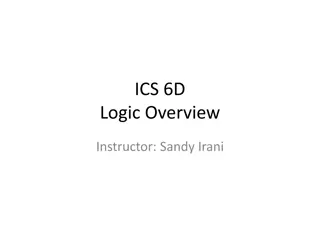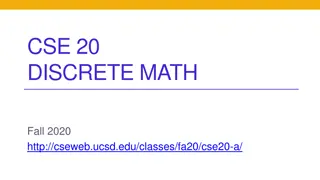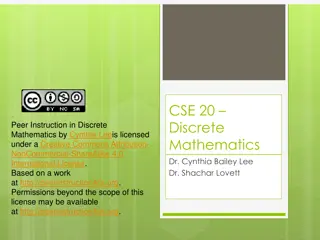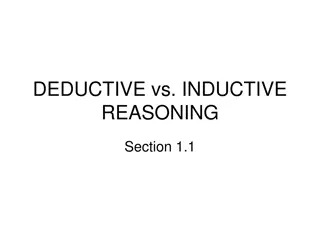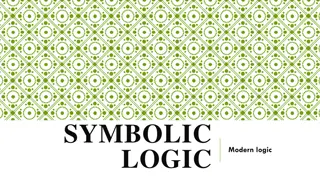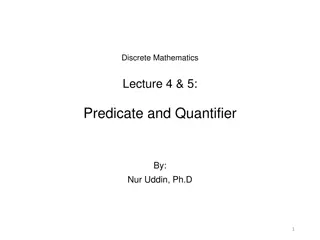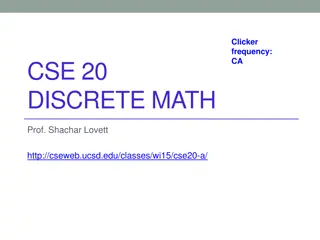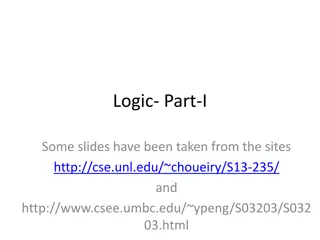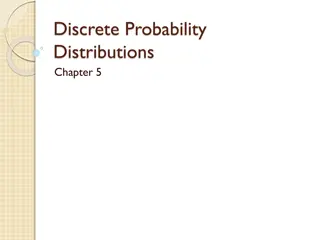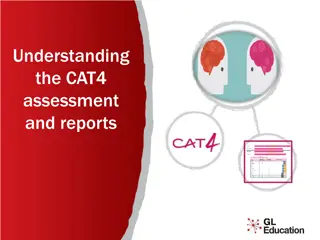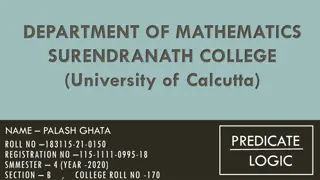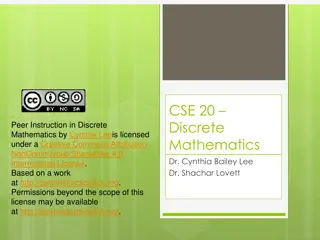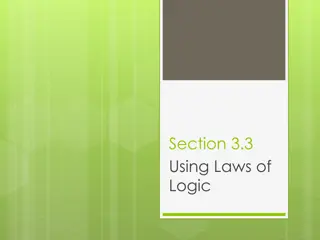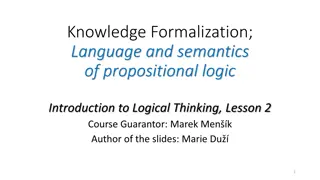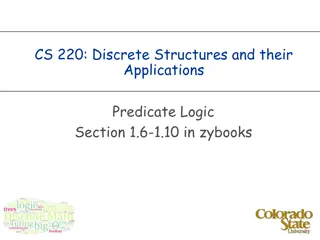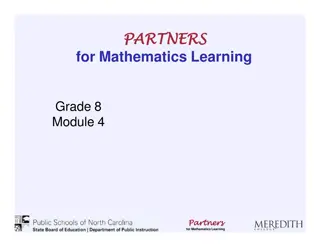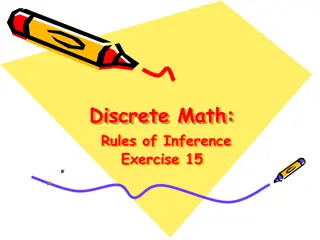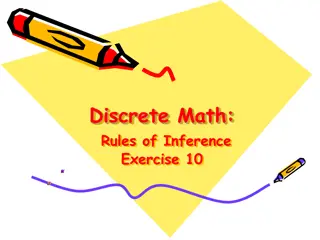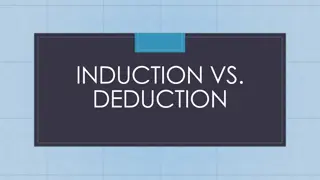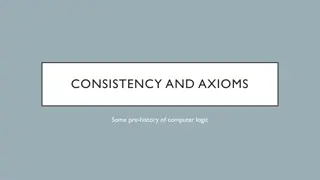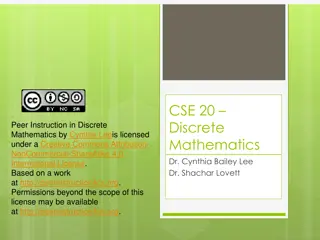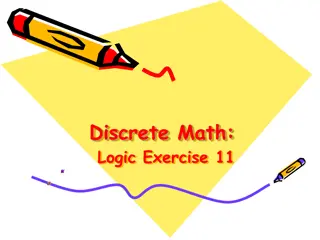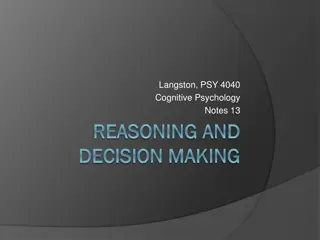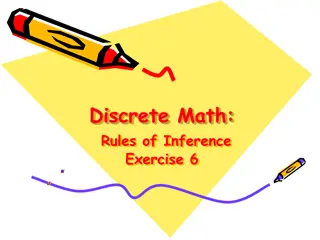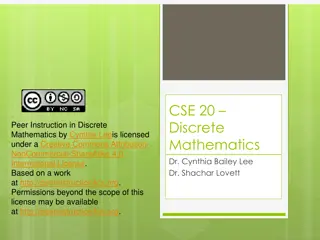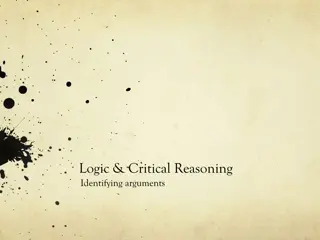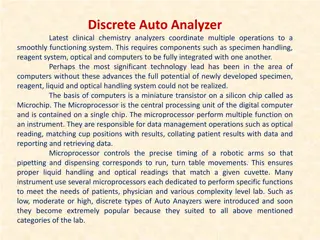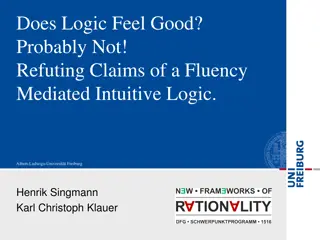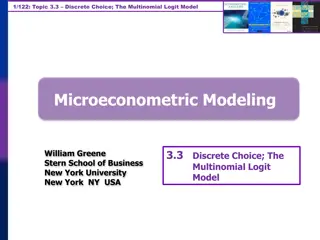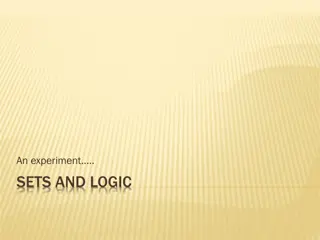Understanding Discrete Mathematics: Logic and Reasoning
Explore the fundamentals of mathematical logic, statements, connectives, and truth tables in the context of Discrete Mathematics. Delve into the theory of inference and the uses of logic in various fields such as Computer Science and the Natural Sciences. Gain insights into negation as a connective that modifies statements and learn how to analyze and construct logical arguments.
Uploaded on Sep 20, 2024 | 0 Views
Download Presentation

Please find below an Image/Link to download the presentation.
The content on the website is provided AS IS for your information and personal use only. It may not be sold, licensed, or shared on other websites without obtaining consent from the author. Download presentation by click this link. If you encounter any issues during the download, it is possible that the publisher has removed the file from their server.
E N D
Presentation Transcript
G. Pullaiah College of Engineering and Technology Discrete Mathematics Department of Computer Science & Engineering Dr K Sreenivasulu
UNIT-I Statements and Notations Connectives Normal Forms Theory of Inference
Mathematical Logic Logic Deals with the methods of reasoning. Provides rules and techniques for determining whether a given argument is valid. Concerned with all kinds of reasoning Legal arguments. Mathematical proofs. Conclusions in scientific theory based upon set of hypotheses. Main aim Provide rules that determine whether any particular argument or reasoning is valid (correct).
Uses of Logic reasoning Mathematics to prove theorems. Computer Science to verify the correctness of programs and to prove theorems. Natural and Physical Sciences to draw conclusions from experiments. Social Sciences, and everyday lives to solve a multitude of problems.
Statements/Propositions and notations Primitive/Primary/Atomic/Simple statements Declarative statements: Cannot be further broken down or analyzed into simpler sentences Have one and only of two possible truth-values. true (T or 1) false (F or 0) Denoted by distinct symbols A, B, C, , P, Q, . Ex: P : The weather is cloudy. Q : It is raining today. R : It is snowing.
Truth Table Summary of the truth-values of the resulting statements for all possible assignments of values to the statements. Connectives Negation Conjunction Disjunction Conditional BiConditional
Negation ( , ~, not, --) Connective that modifies a statement. Unary operation operates on a single statement. Formed by introducing the word not at a proper place in the statement or by prefixing the statement with the phrase It is not the case that . ~P or not P. Truth Table P T F ~P F T
P: London is a city ~P :London is not a city ~P :It is not the case that London is a city P: I went to my class yesterday ~P : I did not go to my class yesterday ~P : I was absent from my class yesterday ~P : It is not the case that I went to my class yesterday
Conjunction ( ) P Q (P and Q). Truth-value T whenever both P and Q have the truth-values T; otherwise truth-value F. Truth Table P Q T F F F P T T F F Q T F T F
Ex: P : The weather is cloudy. Q : It is raining today. P Q : The weather is cloudy and it is raining today.
Ex: P: It is raining today Q: There are 20 tables in this room It is raining today and there are 20 tables in this room Jack and Jill went up the hill Jack went up the hill and Jill went up the hill P : Jack went up the hill Q : Jill went up the hill Roses are red and violets are blue He opened the book and started to read
Disjunction / inclusive or ( ) P Q (P or Q). Truth value F only when both P and Q have the truth value F; otherwise Truth-value T. Truth Table P Q T T T F P T T F F Q T F T F
Ex: P : The weather is cloudy. Q : It is raining today. P Q : The weather is cloudy or it is raining today.
Examples: I shall watch the game on television or go to the game There is something wrong with the blub or with the wiring Twenty or thirty animals were killed in the fire today
Exclusive or Either P is true or Q is true, but not both. Truth Table P Q F T T F P T T F F Q T F T F
Implication or Conditional P Q P premise, hypothesis, or antecedent of the implication. Q conclusion or consequent of the implication. Truth Table P Q Q T F T T P T T F F T F T F
Valid principles of implication that are sometimes considered paradoxical. i) A False antecedent P implies any proposition Q. ii) A True consequent Q is implied by any proposition P. PimpliesQ ifPthenQ Ponly ifQ Pis a sufficient condition forQ Qis a necessary condition forP Qif P Qfollows fromP QprovidedP Qis a consequence ofP Qwhenever P
Examples: P: the sun is shining today Q: 2 + 7 > 4 If the sun is shining today, then 2 + 7 > 4 If I get the book , then I shall read it tonight If I get the book, then this room is red If I get the money, then I shall buy the car If I do not buy the car even though I get the money
If either Jerry takes Calculus or Ken takes Sociology, then Larry will take English J: Jerry takes Calculus K: Ken takes Sociology L: Larry takes English (J K) L The crop will be destroyed if there is a flood C: The crop will be destroyed F: There is a flood F C
Biconditional Biconditional P Conjunction of the conditionals P Q and Q P. Q True : when P and Q have the same truth-values. False : otherwise. P if and only if Q - P iff Q - P is necessary and sufficient for Q P Q P Q T T T T F F F T F F F T
Truth table P Q T F T T Q P T T F T P Q T F F T P T T F F Q T F T F Construct the truth table for the formula ~(P Q) (~P ~Q)
Well-formed formulas (WFF) Expression consisting of statements (Propositions/variables) parentheses connecting symbols.
A statement variable standing alone is a well-formed formula. If A is a well-formed formula, then ~A is a well-formed formula. If A and B are well-formed formulas, then (A B), (A B), (A B), and (A B) are well-formed formulas. A string of symbols containing the statement variables, connectives, and parentheses is a well-formed formula, iff it can be obtained by finitely many applications of 1, 2, and 3 above.
Propositional Functions Variables are propositions. Truth Table P Q ~P Q ~Q ~P P Q ~P ~Q Converse Q P Opposite ~P ~Q T T T F T F T T T T F F F F T F T T F T T T T F T F F F F T T T T T T T
Tautologies A statement formula which is true regardless of the truth values of the statements which replace the variables in it is called a universally valid formula or a tautology or a logical truth A statement formula which is false regardless of the truth values of the statements which replace the variables in it is called a contradiction
Propositional functions of two variables: P F F T T Q F T F T 1 T T T T Universally true or Tautology 2 F T T T (P Q) 3 T F T T Q P 4 F F T T (P) 5 T T F T P Q 6 F T F T (Q) 7 T F F T P Q 8 F F F T (P Q) 9 T T T F ~(P Q) 10 F T T F ~(P 11 T F T F (~Q) 12 F F T F ~(P 13 T T F F (~P) 14 F T F F ~(Q 15 T F F F ~(P Q) 16 F F F F Universally false or contradiction Q) or P / Q Q) or P / Q P) or P / Q
DeMorgans laws ~(P Q) (~P) (~Q) and ~(P Q) (~P) (~Q) Law of Double Negation P ~(~P). (P Q) (~P) Q (P Q) (~P ~P) (Law of contrapositive) (Law of implication) Contrapositive Contrapositive of P Q ~Q ~P
Converse Converse of P Q Q P Opposite/Inverse Opposite/Inverse of P Q (~P) (~Q) Tautology / Identically True Propositional function whose truth-value is true for all possible values of the propositional variables. Ex: P ~P.
Contradiction / Absurdity / Identically False Propositional function whose truth-value is always false. Ex: P ~P. Contingency Propositional function that is neither atautologynor a contradiction. Tautologies 1. (P Q) P 2. (P Q) Q 3. P (P Q) 4. Q (P Q) 5. ~P (P Q) 6. ~(P Q) P 7. (P (P Q)) Q 8. (~P (P Q)) Q 9. (~Q (P Q)) ~P 10. ((P Q) (Q R)) (P R)
Equivalence of Formulas/Logical Equivalence Two well-formed formulas A and B are said to be equivalent, if the truth value of A is equal to the truth value of B for every one of the 2n possible sets of truth values assigned. The Statement formulas A and B are equivalent provided A tautology. B is a It is represented by A <=> B Equivalent Formulas: Commutative Properties P Q Q P P Q Q P Associative Properties P (Q R) (P Q) R P (Q R) (P Q) R
Distributive Properties P (Q R) (P Q) (P R) P (Q R) (P Q) (P R) Idempotent Properties P P P P P P Properties of Negation (De Morgan s Law) ~(~P) P ~(P Q) (~P) (~Q) ~(P Q) (~P) (~Q)
Identity Law P T P P F P Domination Law P T T P F F Absorption Law P (P Q) P P (P Q) P Law of Complementation P ~P T P ~P F
Properties of operations on equivalence (P Q) ((~P) Q) (P Q) (~Q ~P) (P Q) ((P Q) (Q P)) ~(P Q) (P ~Q) ~(P Q) ((P ~Q) (Q ~P)) P Q (P Q) (~P ~Q)
Tautological Implications A Statement P is said to tautologically imply a Statement Q if and only if P Q is a tautology. We shall denote this as P =>Q. Here, P and Q are related to the extent that, Whenever P has the truth value T then so does Q.
Implications: P^Q=>P P^Q=>Q P=>PVQ ~P=>P->Q Q=>P->Q ~(P->Q) => P ~(P->Q) => ~Q P^ (P->Q) => Q ~Q ^ (P->Q) => ~P ~P ^ (PvQ)=>Q (P->Q)^(Q->R)=>P->R (PvQ) ^ (P->R)^(Q->R)=>R
Duality Law Two formulas A and A* are said to be duals of each other if either one can be obtained from the other by replacing ^ by v and v by ^. A(P,Q,R) : P v (Q ^ R) A*(P,Q,R) : P ^ (Q v R) If the formula A contains special variables T or F then its dual A* is obtained by replacing T by F and F by T. The connectives ^ and v are called duals of each other.
Theorem Statement: let A an A* are dual formulas and P1,P2, .Pn be all the atomic variables that occur in A and A*.We write as A(P1,P2, .Pn) A*(P1,P2, .Pn ) then we say that ~ A(P1,P2, .Pn ) A*(~P1,~P2, .~Pn ) Using the demorgan s law: ~(P Q) (~P) (~Q) ~(P Q) (~P) (~Q) We can show ~ A(P1,P2, .Pn ) A*(~P1,~P2, .~Pn ) Thus, the negation of the formula is equivalent to its dual in which every variable is replaced by its negation.
Example: Verify the equivalence of A(P,Q,R) : ~P ^ ~(Q v R) A*(P,Q,R) : ~P v ~(Q ^ R)
Normal forms Let A(P1,P2, , Pn) be a statement formula where P1,P2, , Pn are the atomic variables. If we consider all possible assignments of the truth values to P1,P2, , Pn and obtain the resulting truth values of the formula A. Such a truth table contains 2n rows. If A has the truth value T for at least one combination of truth values assigned to P1,P2, , Pn then A is said to be satisfiable. The problem of determining , in a finite number of steps, whether a given statement formula is a tautology or a contradiction or at least satisfiable is known as a decision problem.
Elementary Product Product of the variables and their negations in a formula. Ex: P Q ~P Q ~Q P ~P P ~P Q ~P
Elementary Sum Sum of the variables and their negations in a formula. Ex: P ~P Q ~Q P ~P P ~P Q ~P Factor of the elementary sum or product any part of an elementary sum or product, which is itself is an elementary sum or product. Ex: Factors of ~Q P ~P ~Q P ~P ~Q P
Disjunctive Normal Forms A formula equivalent to a given formula and consists of a sum of elementary products of the given formula. Examples 1. ObtainDisjunctive Normal Form of P (P P (P Q) P (~P Q) (P ~P) (P Q) Q).
2.ObtainDisjunctive Normal Form of ~(P Q) ~(P Q) (P Q) (~(P Q) (P Q)) ((P Q) ~(P Q)) (P Q). ~(P Q) (P Q) (~P ~Q P Q) ((P Q) (~P ~Q) since [R S (R S) (~R ~S)] (~P ~Q P Q) ((P Q) (~P ~Q)) (~P ~Q P Q) ((P Q) ~P) ((P Q) ~Q) (~P ~Q P Q) (P ~P) (Q ~P) (P ~Q) (Q ~Q)
Conjunctive Normal Forms A formula equivalent to a given formula and consists of a product of elementary sums of the given formula. Examples 1. ObtainConjunctive Normal Form of P (P P (P Q) Q). P (~P Q)
Principal Disjunctive Normal Forms Let P and Q be two statement variables. Let us construct all possible formulas which consists of conjunctions of P or its negation and conjunctions of Q or its negation. None of the formulas should contain both a variable and its negation. Ex: either P Q or Q P is included but not both. For two variables P and Q , there are 22 such formulas given by P Q, P ~ Q , ~ P Q and ~ P ~ Q these formulas are called min-terms.
From the truth tables of these minterms, it is clear that no two minterms are equivalent Each minterm has the truth value T for exactly one combination of the truth values of the variables P and Q. For a given formula , an equivalent formula consisting of disjunction of minterms only is known as its principal disjunctive normal form. Also called sum-of products canonical form.
Principal Conjunctive Normal Forms Let us construct all possible formulas which consists of conjunctions of P or its negation and conjunctions of Q or its negation. None of the formulas should contain both a variable and its negation. Ex: either P Q or Q P is included but not both. For two variables P and Q , there are 22 such formulas given by P Q, P ~ Q , ~ P Q and ~ P ~ Q these formulas are called maxterms.
For a given formula , an equivalent formula consisting of conjunctions of maxterms only is known as its principal conjunctive normal form. Also called products-of-sums canonical form.
Obtain the principal disjunctive normal forms of the following. ~P Q (P Q) (~P R) (Q R). P (~P (~Q ~R)) Obtain the principal conjunctive normal forms of the following. (~P R) (Q P) (Q P) (~P Q) Show that the following are equivalent formulas. P (P Q) P P (~P Q) P Q
Theory of Inference The main function of the logic is to provide rules of inference, or principles of reasoning. The theory associated with such rules is known as inference theory because it is concerned with the inferring of a conclusion from certain premises. When a conclusion is derived from a set of premises by using the accepted rules of reasoning, then such a process of derivation is called a deduction or formal proof. In a formal proof, every rule of inference that is used at any stage in the derivation is acknowledged.





